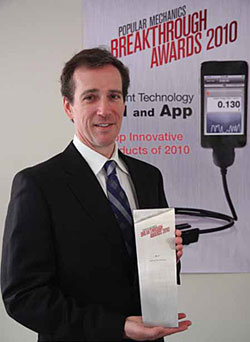
 The call came through on Brennan Hamilton's cell phone when he and his family were vacationing last September. As calls go, they don't get much better when you're operating a small startup company in what might best be described as an uber-competitive automotive/electronics/applications/geek gear market.
The call came through on Brennan Hamilton's cell phone when he and his family were vacationing last September. As calls go, they don't get much better when you're operating a small startup company in what might best be described as an uber-competitive automotive/electronics/applications/geek gear market.
The caller was from Popular Mechanics magazine telling Hamilton---a '95 University of Michigan-Dearborn MSE alumnus---that a product called the GL1 that Hamilton's company, GoPoint Technology, recently had developed had won the magazine's prestigious Breakthrough Product Award.
"The call," Hamilton said, "basically went something like this: 'Hey, you've been selected for this award. If we give it to you, will you show up at our ceremony?'"
The ceremony in New York City at the Hearst Tower would involve being recognized alongside other winners, including a woman working to kill cancer with light and a genetic engineer who, as Hamilton put it, "basically was creating life" via his DNA research. These individuals had won in different categories, but networking is networking. Hamilton bought some plane tickets.
As heady as sharing cocktails and headlines with such stars was, the real benefit for Hamilton was more practical, though no less exhilarating. "Once the shock wore off, I realized this was an awesome opportunity to get the word out on the product. For a startup company with limited PR resources and just six employees, we went from zero to being in front of the whole U.S. at the Hearst Tower."
That's what can happen when you create a great product at the right time with the right price tag-all of which describe the GL1. Basically, the $100 device is an application that plugs into a car's dashboard and determines why the "check engine" light just went on.
The application, which operates on Apple products like the iPhone and iPad, saves drivers the cost of going to an auto repair shop or dealership to find out why that light is on, which could be as simple as forgetting to put the gas cap back on after filling the tank.
It's not surprising that the GL1 has received other recognition, as well. It was a TiE20 winner in the Mobile Category. This competition is relatively new and is operated by the TiE Detroit, which hosts Michigan's largest conference on entrepreneurship.
"That was an awesome award, considering they're honoring companies that are multi-nationals that just happen to have offices in the Midwest," said Hamilton.
So 2010 was a very, very good year for Hamilton and GoPoint Technology, based in Rochester Hills, Mich.
In many ways, all of this began when Hamilton decided to earn his master's degree in electrical engineering at UM-Dearborn. He took several classes taught by Yi Lu Murphey, chair and professor of electrical and computer engineering. It was in one of her classes, he said, "that I learned more about embedded systems and programming-artificial intelligence kind of stuff. It was one of her classes that forced me to learn an embedded language."
Hamilton and Murphey later collaborated on research with funding from the National Science Foundation and Ford Motor Company. "That's what really set me on the path to embedded systems and programming," Hamilton said.
Hamilton grew up in Highland, Mich., and graduated from Milford High School in 1985. He always had been interested in automotive engineering. He was a General Motors Corporation co-op student from 1985 to 1990 and earned his bachelor's degree in electrical engineering at Kettering University, then General Motors Institute, in 1990. It was at Kettering, by the way, where he met his wife, Lori, who partners with her husband in running GoPoint. The couple lives in Birmingham, Mich., and has three children, ages 11 to 15.
Hamilton began working at Ford Motor Company in 1990 while working on his master's degree. During his time at Ford, he ran a kind of hobby-business putting together embedded systems and programming for the Palm operating system. The business grew quickly, and in 2007, when Ford offered employees buyouts, Hamilton jumped.
He established Hamilton Performance Electronics that year. In 2008, he decided he needed a more apt name. "I wanted to move beyond me in the name. I had read a book on the 'go point'-the point in the decision-making process where you make the decision to go ahead and do something.
"I decided," Hamilton said.
Meanwhile, Apple, Inc. was coming out with its iPhone and related products. By 2009, Hamilton said, Apple executives "decided they would let accessories hook up to their phones. By then, we already had vehicle interface technology, so I decided we were going to make a product that would hook up to the iPhone."
One key to the product's low price and simplicity is that it plugs into existing ports, or connectors, that have been standard equipment on vehicles since 1996. So buyers don't have to do anything but buy the cable. One end of the cable plugs into the dashboard and the other into an iPhone, iPod Touch, or iPad.
Hamilton said there are some very large potential buyers for the GL1. Meanwhile, GoPoint will continue to develop its niche onboard diagnostic (OBD) product. Next up: the Bluetooth edition of GL1.
Article reprinted with permission from Dearborn Engineer.





